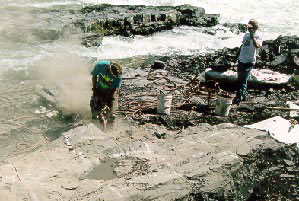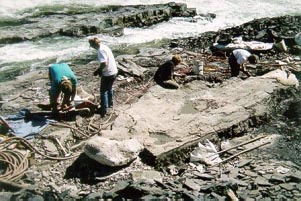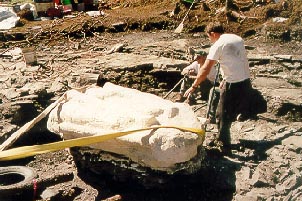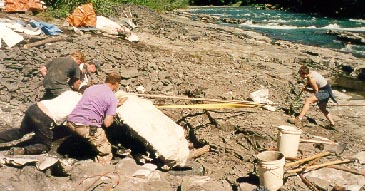








Process
Because so many factors are involved in the excavation process, it would be impossible to accurately describe a paleontological dig in general. By describing the process of excavation at the Pink Mountain site, near Fort Nelson, British Columbia one can understand how the process works. This particular site contains a bone bed and has much more than just one Icthyosaur: Nautiloids, Ammonites, fish, Bivalves, Mixsosaurs, etc...

An excavation may vary from location to location. It all depends on the site, where it is in the wood (is it cold or hot there?),
what kind of material the fossil is embedded in (hard or soft rock, or sand or ice), how far away is it from civilization (are you
in the Arctic or in Vancouver?) In this case, the site is fairly remote and so the equipment we needed such as an air compressor,
rock saws, picks, water and food had to all be flown in by helicopter.

After receiving our equipment, we got to work on setting up a first aid tent and a tarp for us to stand under in case of rain or retreats from the sun during lunch breaks. We would then clear off all the soil and fully expose the surface of the rock that held the Icthyosaur. A grid would then be made overtop of all the exposed rocks. Each square would be made 1 meter by 1 meter and labeled alphabetically laterally and numerically. The grid would then be sketched onto paper and would have the fossils that could be seen by the naked eye placed onto the grid.

The jackhammers, rocks saws, zip guns were used to fully expose the fossils that had been seen before. Once the materials had been removed to a satisfactory level, the fossils would be undercut and have a trench dug around the fossil. The undercutting is the process of making a hang notch along the side of the block, that would stretch about an inch under. The trench makes it easier to flip a block by giving the paleontologist leverage in flipping the block with a pry bar. In the excavation the trench had to be about two and a half feet wide and could go down from one to four inches deep. The blocks could anything from 30 pounds to 1,500 pounds.

Throughout the excavation process, the grid, which was originally spray-painted on, could be scraped and eroded off so it had to be repainted about one every two weeks. This repainting would aid the other crews that would come in to help to orient themselves with the process. The process would result in muiltiple shifts of people. A log would be made of progress and drawings of the grids showing everything. The grid is also used later on when doing research on the fossils to gather information about the placement. How the fossil died, what kind of relationship it had with the Icthyosaur, could sometimes be determined from the grid.

Once the fossils have been sufficiently undercut, exposed and had a trench around it, the fossil would be covered in a wet paper towel. This would then provide a dividing (protective) layer from the plaster fiber glass or burlap that would be placed overtop the material and fossil. After the plaster dries and hardened, pry bars and chisels were used to be driven under the block to flip it over. Once it had been flipped over, the process would then be repeated.

Once all the fossils had been uncovered, plastered, and flipped over everything was packed up. Helicopter cargo nets were used to transport the equipment and fossils out of the site. The fossils were then driven to the Royal Tyrrell Museum in Alberta, where the next few years they would be prepped, studied, and then finally displayed for the public to see.
When the fossil specimen reached the museum, scientists first cleaned, then prepared the fossil, and using mechanical extraction, removed the fossil from the rock matrix. If mechanical extraction was not possible then scientists would have had to use the chemical approach: acid. With the fossil now fully exposed, scientists were able to interpret and study the fossil to a greater extent. For rare and valuable finds the museum will have casts and molds created for their displays.
Ichthyosaur
Tools Paleontologists Use
Pink Mountain